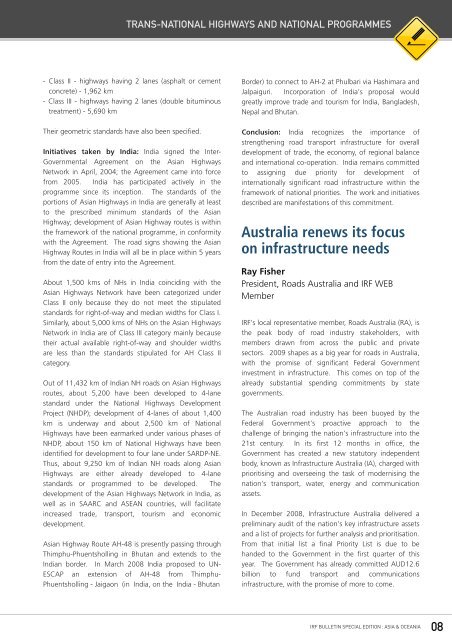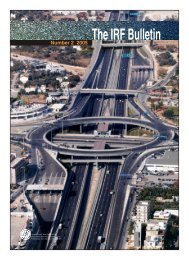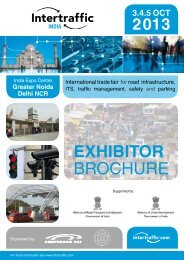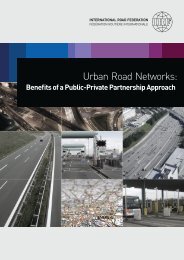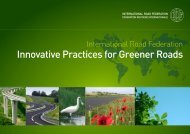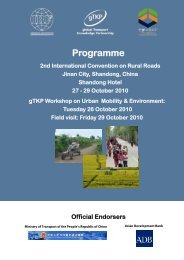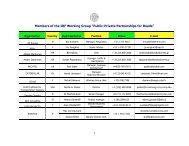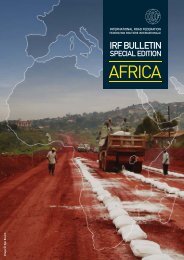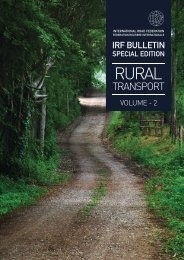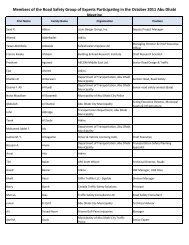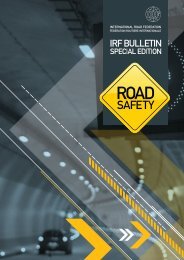Download - IRF | International Road Federation
Download - IRF | International Road Federation
Download - IRF | International Road Federation
You also want an ePaper? Increase the reach of your titles
YUMPU automatically turns print PDFs into web optimized ePapers that Google loves.
TRANS-NATIONAL HIGHWAYS AND NATIONAL PROGRAMMES<br />
- Class II - highways having 2 lanes (asphalt or cement<br />
concrete) - 1,962 km<br />
- Class III - highways having 2 lanes (double bituminous<br />
treatment) - 5,690 km<br />
Their geometric standards have also been specified.<br />
Initiatives taken by India: India signed the Inter-<br />
Governmental Agreement on the Asian Highways<br />
Network in April, 2004; the Agreement came into force<br />
from 2005. India has participated actively in the<br />
programme since its inception. The standards of the<br />
portions of Asian Highways in India are generally at least<br />
to the prescribed minimum standards of the Asian<br />
Highway; development of Asian Highway routes is within<br />
the framework of the national programme, in conformity<br />
with the Agreement. The road signs showing the Asian<br />
Highway Routes in India will all be in place within 5 years<br />
from the date of entry into the Agreement.<br />
About 1,500 kms of NHs in India coinciding with the<br />
Asian Highways Network have been categorized under<br />
Class II only because they do not meet the stipulated<br />
standards for right-of-way and median widths for Class I.<br />
Similarly, about 5,000 kms of NHs on the Asian Highways<br />
Network in India are of Class III category mainly because<br />
their actual available right-of-way and shoulder widths<br />
are less than the standards stipulated for AH Class II<br />
category.<br />
Out of 11,432 km of Indian NH roads on Asian Highways<br />
routes, about 5,200 have been developed to 4-lane<br />
standard under the National Highways Development<br />
Project (NHDP); development of 4-lanes of about 1,400<br />
km is underway and about 2,500 km of National<br />
Highways have been earmarked under various phases of<br />
NHDP, about 150 km of National Highways have been<br />
identified for development to four lane under SARDP-NE.<br />
Thus, about 9,250 km of Indian NH roads along Asian<br />
Highways are either already developed to 4-lane<br />
standards or programmed to be developed. The<br />
development of the Asian Highways Network in India, as<br />
well as in SAARC and ASEAN countries, will facilitate<br />
increased trade, transport, tourism and economic<br />
development.<br />
Asian Highway Route AH-48 is presently passing through<br />
Thimphu-Phuentsholling in Bhutan and extends to the<br />
Indian border. In March 2008 India proposed to UN-<br />
ESCAP an extension of AH-48 from Thimphu-<br />
Phuentsholling - Jaigaon (in India, on the India - Bhutan<br />
Border) to connect to AH-2 at Phulbari via Hashimara and<br />
Jalpaiguri. Incorporation of India's proposal would<br />
greatly improve trade and tourism for India, Bangladesh,<br />
Nepal and Bhutan.<br />
Conclusion: India recognizes the importance of<br />
strengthening road transport infrastructure for overall<br />
development of trade, the economy, of regional balance<br />
and international co-operation. India remains committed<br />
to assigning due priority for development of<br />
internationally significant road infrastructure within the<br />
framework of national priorities. The work and initiatives<br />
described are manifestations of this commitment.<br />
Australia renews its focus<br />
on infrastructure needs<br />
Ray Fisher<br />
President, <strong>Road</strong>s Australia and <strong>IRF</strong> WEB<br />
Member<br />
<strong>IRF</strong>'s local representative member, <strong>Road</strong>s Australia (RA), is<br />
the peak body of road industry stakeholders, with<br />
members drawn from across the public and private<br />
sectors. 2009 shapes as a big year for roads in Australia,<br />
with the promise of significant Federal Government<br />
investment in infrastructure. This comes on top of the<br />
already substantial spending commitments by state<br />
governments.<br />
The Australian road industry has been buoyed by the<br />
Federal Government's proactive approach to the<br />
challenge of bringing the nation's infrastructure into the<br />
21st century. In its first 12 months in office, the<br />
Government has created a new statutory independent<br />
body, known as Infrastructure Australia (IA), charged with<br />
prioritising and overseeing the task of modernising the<br />
nation's transport, water, energy and communication<br />
assets.<br />
In December 2008, Infrastructure Australia delivered a<br />
preliminary audit of the nation's key infrastructure assets<br />
and a list of projects for further analysis and prioritisation.<br />
From that initial list a final Priority List is due to be<br />
handed to the Government in the first quarter of this<br />
year. The Government has already committed AUD12.6<br />
billion to fund transport and communications<br />
infrastructure, with the promise of more to come.<br />
<strong>IRF</strong> BULLETIN SPECIAL EDITION : ASIA & OCEANIA<br />
08


